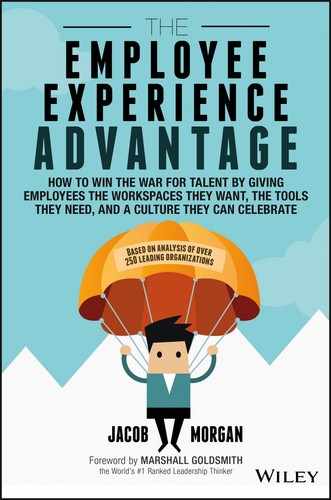CHAPTER 21
What about the Actual Work?
One thing is quite obviously missing from all the discussions around employee experience: the actual work that employees have to do. Put more directly, the question that people oftentimes ask me is “How does the actual work impact the employee experience?” It's a very fair question to ask, and the work does affect the experience. However, it wasn't included in this book for one crucial reason. In almost all cases the organization doesn't control the work you do, but it controls the environment in which it gets done. Usually, you decide on the work.
When you apply for a job, you should have a pretty good sense of what the role is, what you will be doing, and what's expected of you. In other words, you are picking the job, and there shouldn't be that many surprises. If you get hired in sales, chances are you won't get asked to go fix a server issue, and if you get hired in customer service, you most likely won't have to give a presentation on sales performance. Of course, I'm not naive enough to think that we all have the luxury of leisurely picking our jobs and the organizations we work for. Plenty of people around the world are simply willing to take any job to pay their rent. Even in these situations the environment in which we work has an impact, and even in these situations the employee knows what he or she is getting into. This means that employees need to have a certain level of self‐awareness to determine their careers, the organizations they want to work for, and the roles they want to have. Of course when first entering the workforce this is something most of us struggle with but must also develop over time.
If you think about it, the organization can't change the work you do. If you get hired as an engineer, the code needs to be written. If you're hired as a sales professional, the deals need to be closed. If you get hired as a customer service representative, then the customers need to be helped. In this case the variable isn't the actual work itself; it's how the work gets done. I see this all time when speaking with employees at different organizations who have the same roles and functions. The jobs and tasks are virtually identical, but the environment in which they are done is different. This, of course, should come as no surprise. In fact many of us have experienced this in the course of our careers. I certainly have. Perhaps you were on the marketing team of a particular organization, and after a year or so of working there, you started to hate your job. You didn't feel appreciated, your manager didn't care about you, and you didn't feel like you were having much of an impact. As a result you switched jobs and worked for a similar organization where your job was pretty much the same. A year goes by and you're much happier. Your manager is always checking in on you to see how you're doing, frequent socials with your team members are organized to create a stronger employee bond, and you really feel like you're making a difference. The work itself didn't change, but the environment in which the work was done changed. That's what made the impact.
As I was going through the data I collected, I noticed many instances where organizations in the same industries that did pretty much the same thing scored quite differently on the Employee Experience Index. How come? I suppose it is possible that some organizations are just so amazing at always picking the exact right people that they always have a perfect match between what the employee wants, needs, and expects and what the organization actually delivers. I have yet to meet organizations like this, and just like Bigfoot or the Loch Ness Monster, chances are they are fictional creatures. Everything I have researched and seen points to the environments in which the work gets done as the cause for such variations in score.
Let's compare Mercedes‐Benz, a company that scored in the lowest category, inExperienced, and Toyota, a company that scored in the Engaged category. Both companies essentially do the same thing. They manufacture, market, and sell cars. The difference is that Toyota does a much better job of influencing how employees' jobs get done and how they feel about doing those jobs. When comparing the data, Toyota scored just slightly higher than Mercedes in most of the variables, but there are two areas where the score difference was significant. Employees at Toyota feel more valued, and they feel like they are being treated more fairly than the employees at Mercedes. Even though employees at both organizations may have identical jobs, their experiences are quite different.
Another good example is PepsiCo and Coca‐Cola. Again, they're two organizations that pretty much do the same thing: manufacture, market, and sell food and beverage products. PepsiCo scored in the lowest category, inExperienced (sorry, Pepsi lovers), and Coca‐Cola scored in the Engaged category. Why? Coca‐Cola scored much higher in the areas of learning and development opportunities, working in a physical space that reflects the values of the organization, and feeling proud to bring in friends or visitors to the workplace. Yet again we see the job is the constant and the environment is the variable.
This trend has appeared across many of the 252 organizations that I have collected data on. The job and the work are constant, and although they do affect the employee experience, that comes from your choice. This is why it's so crucial for all of us to have a great understanding of who we are, what we are good at, and what we want to do. Aside from switching careers or jobs, the only thing the organization can shape is how the work gets done, not what the work is.
